





The Brazilian Skipper is 100% butterfly, even though it has been commonly mistaken for a moth. The flight motion of the skipper is usually quick, skipping from flower to flower, for such they were named. They drink nectar from flowers, and skip only in the daylight hours. Not at night when moths are most active. As a caterpillar, they are not favorably recognized. One might even say they are the underdogs of cats. What if all they need is a formal introduction and a little more information? Then all is well...let's just start all over again!
(Editor's Note: This article was originally published on December 3, 2007.)
Allow me to introduce... The Brazilian Skipper (Calpodes ethlius). They have not always been a citizen here in the United States, however they will be as long as we continue grow Canna[1] in our southern gardens. These fabulous tropical plants are native to the northern regions of South America, the Indies, and Mexico where they and many of our tropical plants also originated. The Canna is one of this skipper's main larval food (caterpillar host) plants. Canna also happen to be one of the most spectacular plants in a Southern garden. North of zone 7, they are either grown in pots (up to zones 2-4), or planted deeper into the soil (in zones 5 & 6). A few of the other names these butterflies are known by, include: Canna Skipper, Arrowroot Butterfly, and Large Leaf Roller. Other lesser larvae will feed on Cannas, however the Brazilian Skipper is the only one among them that has earned a prominent place in lepidoptera. 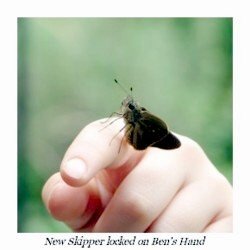
Ushered To The Garden
This is how I have come to know most all the plants that I grow to this day; I was inspired by the creatures who use them for food and sheltering habitat. I was powerfully drawn to the perfection of their complete and profound example of symbiosis. Literally being ushered into their whole unadulterated circle of life, and how my life relates to their metamorphosis. The butterflies instinctively knew what they required long before anyone realized how beautiful their food plants were. Long before ornamental planting came into play. Now I realize that many a beautiful butterfly has fallen short of flying, because humans did not recognize or appreciate them in their larval stage.
Ushered in by these tiny ambassadors, I eventually learned how to grow what they need. It is the reverse for most gardeners, as they first grow the plant, and then discover something eating it. All too often, some very special butterflies end up as a mug shot in the Squashed Bug Hall of Fame. This would explain a good portion of the 2% survival rate of all butterflies. Loss of habitat, and not being correctly identified. I would strongly urge gardeners to make use of the Bug and Insect Identification Forum before taking any action. Then come to the Hummingbird and Butterfly Forum to show us (brag about) what you saved. You will surely find a cheerful response waiting for you there.
Distribution
The skippers establish themselves wherever their hosts are grown, and where habitat and weather can sustain them. Reports of them are noted in many US States farther north, however these are likely strays visiting in summertime. (see map) In the U.S. skippers are more prevalent in Southern zones. By wintertime in the Midwest and deep South, skippers will likely die off . Having no diapause (or hibernation phase), any establishment would be slim to none in the north. Some might have time to make a short migration south before a hard freeze. By far, the heaviest concentration of them in the U.S., will be in California, South Texas, and Florida. Brazilian Skippers will be more prevalent in areas of the south, where their Canna host is grown as a perennial.
to none in the north. Some might have time to make a short migration south before a hard freeze. By far, the heaviest concentration of them in the U.S., will be in California, South Texas, and Florida. Brazilian Skippers will be more prevalent in areas of the south, where their Canna host is grown as a perennial.
A Little Relative History
According to agricultural history, Cannas were imported to the U.S. & Europe by early explorers dating back to the 1500's. The skippers were most likely hidden inside plants as an egg or larvae in cargos of Spanish ships without human knowledge. By land, the Canna hosts moved northward to the U.S., yard to yard via transplanted by neighbors like us sharing the plant. Subsequent migrations of adult Brazilian Skippers were merely following the plantings of the food plants necessary for their offspring.
Life Cycles
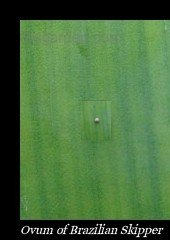
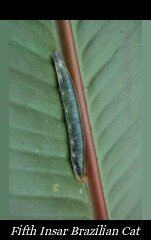
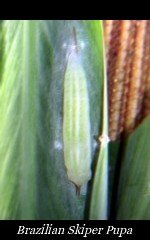
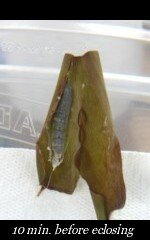
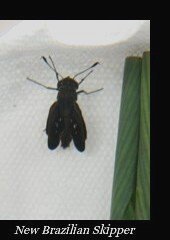
Our Firsthand Experience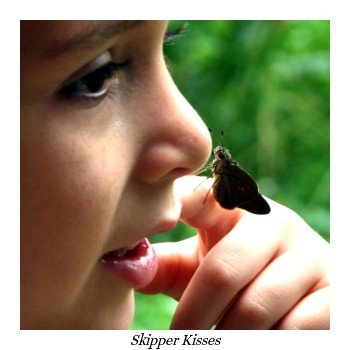
We had the privilege of handling some of these Brazilian Skippers this past Summer, finding and collecting several pupas rolled up in Canna leaves in my daughter's garden. When I held the cylindrical leaves in my hand, I felt an unexpected and very audible vibration. This was caused by the same mechanism which removes feces from the nest. This is called “fecal firing, which is facilitated by the anatomy of the larva's anal comb and the buildup of hemostatic pressure within its terminal abdominal segment (Caveney 1998). It is hypothesized that frass removal may reduce discovery by parasites and predators which often use the odor and sight of frass as clues to the potential presence of hosts or 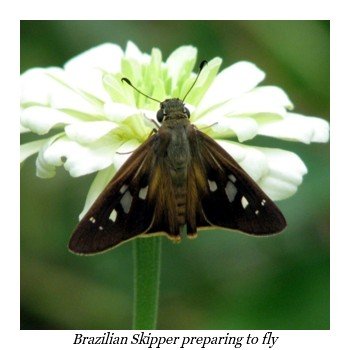 prey.”[2] This motion also carries on into the chrysalis not to remove frass, of course, however to deter larger predators such as reptiles or birds.
prey.”[2] This motion also carries on into the chrysalis not to remove frass, of course, however to deter larger predators such as reptiles or birds.
In order to conserve these skippers just leave them in the garden. The above natural defense(s) will keep them much safer than a cage. It can be just as delightful to witness their eclosure without disturbing the growing larvae at all. Just collect the pupae after they have finished forming their chrysalid(s). To know exactly when to watch the show, note that the pupa cast will become clearer, and no longer green. The brownie skipper will show through, shortly before they eclose.
About a half hour after they eclose as a new butterfly, they are ready to set out into the garden. My son Ben (junior entomologist) took one of them in his hand to hold, and get a closer look. The skipper kept trying to crawl back onto him, even with several attempts to place it on a flower. Finally, we were able to leave it on a sturdy Zinnia. With a firm footing, she twirled around and basked in the sun for an hour or so. At first flight, coupling is always more important to butterflies, skippers and moths than food. Nectars only sustain them for the reproductive function, whereas dining on their larval host made them what they are.
Even after raising hundreds of beautiful butterflies and skippers this far, seeing this particular one to completion was one of the highlights of our Summer. We watched the skippers as they shimmied out of the scrolled leaves through the top end in order to sit and fill out their shriveled wings. Their proportionately large eyes take in their surroundings from a totally new form. As the wings take shape and dry, the colors become surprisingly rich for a little brown butterfly. The diamond shaped markings in shades of gray and white stand out in the light against the smooth chocolaty color of their soft furry wings. The gray and white markings are transparent, though they appear as pearly inlaid jewels.
A New Perspective
Now, when I look upon landscapes with Canna, whether large or small, tattered or immaculate... I think about the flying flowers that rely on them as a major source of food. Let's face it, they were brought over here initially without their choice, however aware or unaware to us. From a skippers point of view maybe a case of catnapping. From my point of view, it only seems fair to give them a place in the garden.
Footnotes:
1. Powdery Thalia is also a larval host for the Brazilian Skipper
2. Quoted from: University of Florida IFAS Extension
To browse Cannas, see all of the 580 listings in the Plant Files,
(265 of them complete with pictures). Also visit the Canna Forum
to participate in discussions about Cannas.
For practical growing information in the South,
see an article by Mitch Fitzgerald. entitled:
"Tropical Dreams - How To Grow Cannas"
If link doesn't click refer to Article dated November 7. 2007
Websites:
The North American Butterfly Association
University of Florida IFAS Extension
Butterflies and Moths of North America
Great Reference Books:
"Butterfly Gardening for the South"
By Geyata Ajilvsgi (Taylor Publishing Co., 1990)
"The Ultimate Guide To Backyard Bugs, Garden Insects of North America"
By Whitney Cranshaw (Princeton University Press 2004)
"Kaufman Focus Guide, Butterflies of North America"
By Jim P. Brock & Kenn Kaufman (Houghton Mifflin Co. 2003)
*Extra Special Thanks to the following members
for use of their photos, and/or overall support:
TexasPuddyPrint - Cat Traylor - photo of Magnified Egg
Sheila_FW - Sheila Franklin - photo of Fifth Instar Brazilian Cat
Critterologist – Jill M. Nicolaus
Melody – Melody Rose
and all the friends of the Daily Butterfly thread
For friendly management of Skippers on your Cannas,
view this Journal page
Copyright © www.100flowers.win Botanic Garden All Rights Reserved